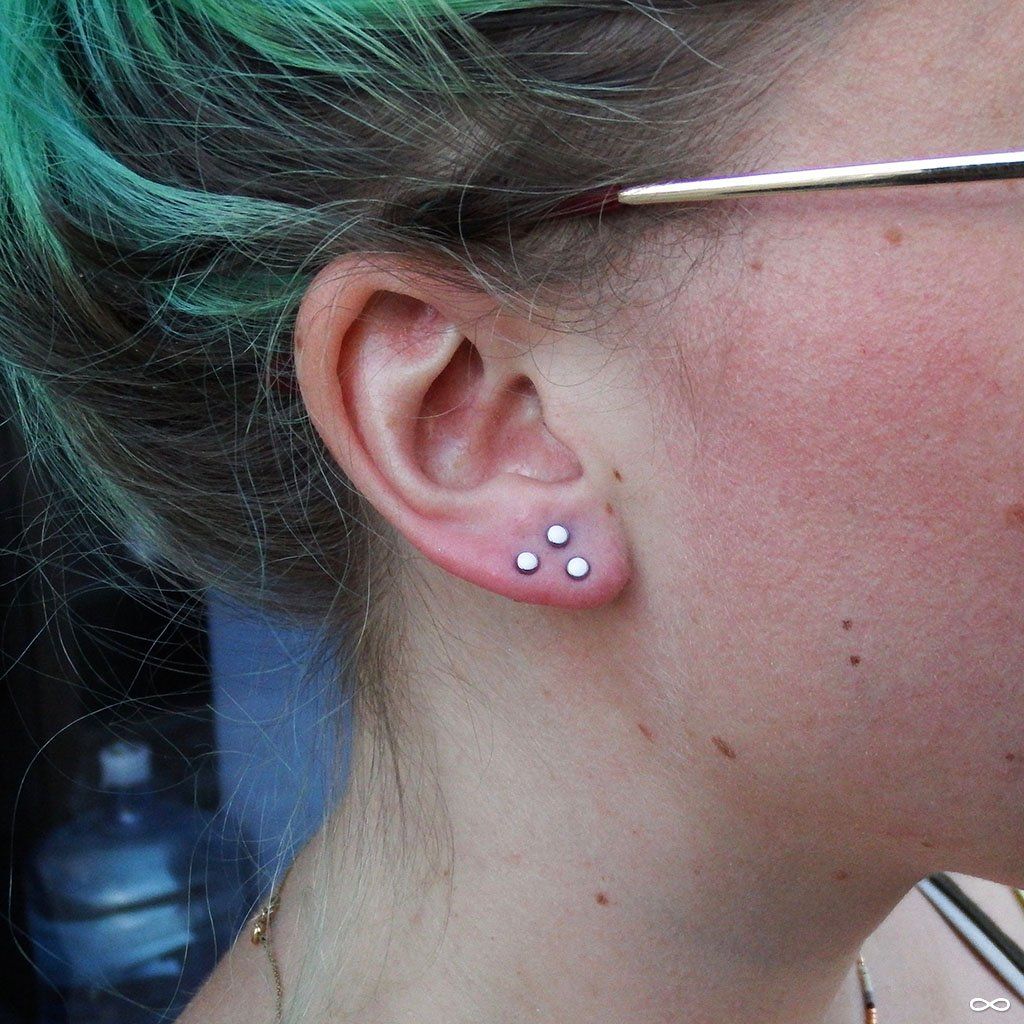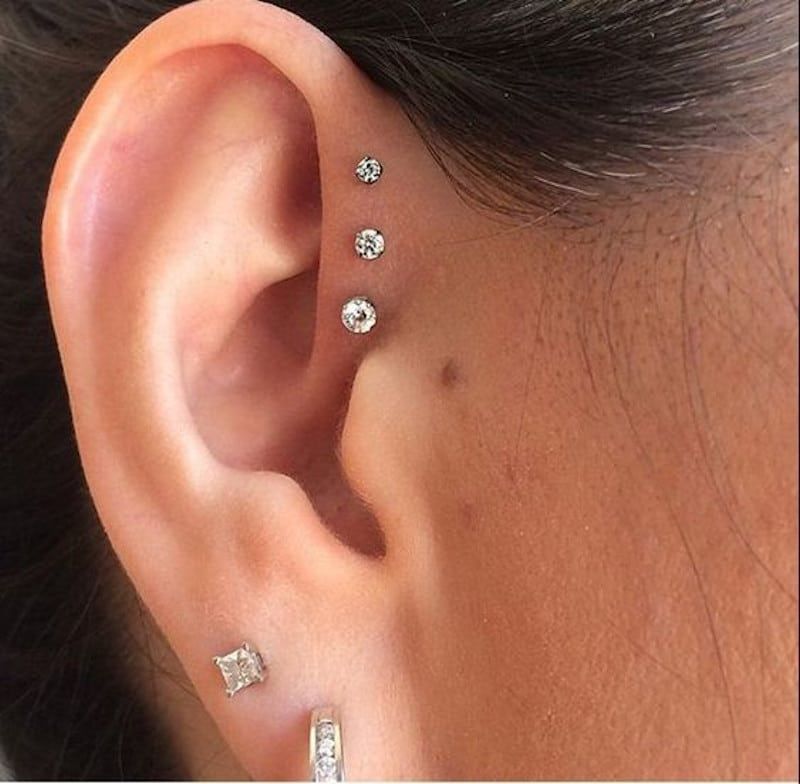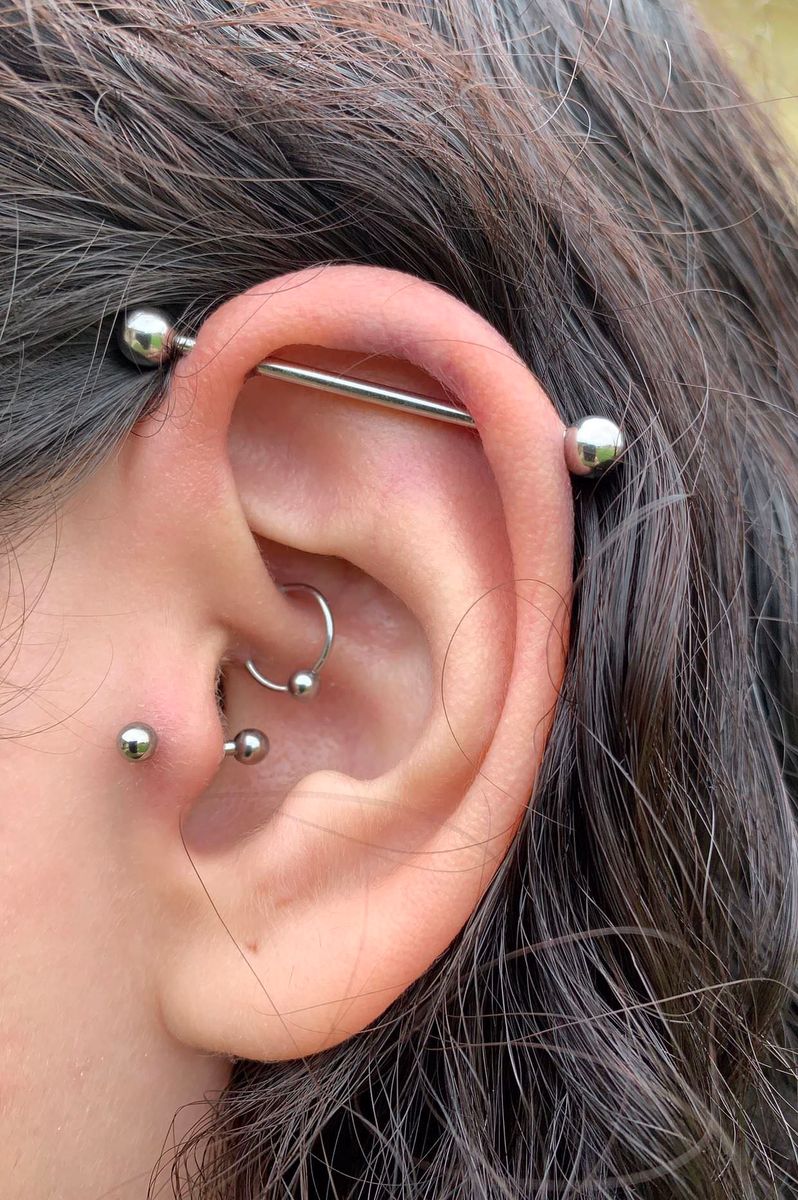One of the few fashion trends that never goes out of style is ear piercings. When it comes to creating a fashionable and unique ensemble, adding a little bit of ear jewelry never goes wrong. However, there are so many kinds of ear piercing out there that it can be confusing. Nowadays, people do not have piercings in both ears. There are more than five piercings in each ear today! If you’re considering getting a piercing and aren’t sure which one you want, our expert guide will help you decide and make you sound well-versed in all the piercings available.
You should do your research before getting an ear piercing, so you know exactly what you want. To learn about all the different types of piercings you can get, continue reading.
Types of Ear Piercings
Contents (Click to Jump)
1. Lobe Piercing
First, let’s go back to the familiar. If you got your first piercing at a Claire’s or a mall jewelry stand, your lobe piercing was likely your first piercing. The piercing goes through the soft, fleshy part of your lower earlobe, so it is less painful than other piercings. It also heals faster, usually within 6 to 9 weeks.
If you don’t want to venture into cartilage territory (which can be more tender and take longer to heal), you can have multiple lobes pierced at the same time. In fact, stacked lobes are another nice way to dress up your ears.
2. Stacked Lobe Piercing
A stacked lobe is a beginner-friendly option that can be customized according to your preference. You can experiment with the number and placement of your lobe piercings to fit your ear (while enjoying the relatively painless and fast healing).
3. Snakebite Piercing
Models like Kaia Gerber have popularized the snakebite style, which involves stacking two piercings closely together. Your healing time will vary depending on how high or low you place them. If they are placed in your earlobe, your healing time will vary as well. Due to the proximity of the two piercings and the fact that you’re doubling them, you should expect more swelling.
4. Conch Piercing
We have a friend in the conch, don’t we? A cartilage piercing can be worn with a simple stud or a cuff, as it lies right in the center of the cartilage. Since it is located in a recessed area, the pain level is described as minimal to moderate (think: a 3 or a 4 on a 10 scale). Healing takes an average of between three and six months following surgery. Shortly, it’s a good intermediate piercing to get if you’re still a little nervous about moving further up your ear.
5. Helix Piercing (AKA Cartilage)
A helix piercing, more commonly known as a cartilage piercing, penetrates the outer rim of your earlobe. Healing times can vary considerably depending on various factors (most notably, your sleeping position) but on average, you should be fine after about six-to-eight months. Starting with studs and letting them heal before switching to rings or other styles is recommended.
6. Forward Helix Piercing
Can you see the single stud on the inner portion of the cartilage that faces forward? That would be a forward helix, and it would take about the same amount of time to heal as a traditional cartilage piercing (6 to 8 months).
7. Tragus Piercing
Tragus is a piercing that doesn’t hurt much to get (it’s described as a pinch or a pressing sensation on the skin), but it can be difficult to heal. TRAGUS piercings go through the dense cartilage that lies just in front of your ear canal, so the part that bumps up against your cheek, which is a tricky place for an earring. Mainly, when putting in earbuds or even holding your phone up to your ear, the way the post sits inside your ear makes it impossible to avoid knocking. However, there’s no denying that they look pretty damn cool.
8. Anti Tragus Piercing
Tragus variations include the anti-tragus, which is named for the way it sits opposite the tragus (through the curve of your inner cartilage). It has a similar level of pain (moderate) and healing time (6 to 8 months) to a forward helix because of its location.
9. Rook Piercing
The rook piercing is situated just above the tragus, along the inner fold of the ear. (You are looking at the small gold ring here.) The pain is described as moderate to intense considering the location and its average healing time is one year. When it comes to a rook piercing, it’s important to keep in mind that not everyone has the right real estate (or anatomy) for one, so be open-minded when you’re in the piercing studio. Fortunately, you have a lot of other options…
10. Snug Piercing
There’s such a cute name for something that’s considered one of the most painful ear piercings out there (if not the most painful). It’s unique in that you can see exactly where the piercing enters and exits your ear, because it sits right above the anti-tragus, or inner ridge of cartilage. The snug, like the rook, is another look you’ll want to consult your piercer about first, as not everyone’s ear will be able to comfortably accommodate it.
11. Daith Piercing
Also called the one that (may) help with anxiety. A popular inner ear piercing, this one passes through the cartilage. One of the few piercings that is recommended to begin with a hoop instead of a stud, to facilitate easier cleaning once it has healed. Whether dressed up or down (we love the way this one has been styled), the daith provides a nice balance to any ear.
12. Industrial Piercing
It is characterized by two distinct punctures connected by a piece of jewelry (usually a bar) and is considered moderately painful. You need to get the placement of this piercing (or perhaps more accurately, piercings) right, as you want the bar to lie at the right angle to facilitate healing.
As an added bonus, we’ve seen a fake-industrial piercing that uses a single puncture in the helix or conch to simulate a similar effect for easier healing.
General Tips for Care
Be sure to research how your piercing needs to be properly cared for before scheduling an appointment for a new ear accessory. Taking care of your piercing will keep it looking #instagood rather than infected. It is not a good idea to twist, turn, rotate, or sleep on any of your piercings, since this increases your risk of infection or irritation, and prolongs the healing process. You should avoid sleeping on them and clean them with saline one to two times per day. For six to eight weeks after getting pierced, you will want to stay away from water (baths, pools, hot tubs, etc.). Additionally, stay away from harsh chemicals such as soap, peroxide, bactine, rubbing alcohol, and Neosporin.
Ear Piercing FAQs
Which is the most painful ear piercing?
It’s important to remember that pain is subjective, so what your friend might describe as a 10 might be more like a five to you. As a result, the snug was the piercing that came up most when ranking pain. The snug, despite its unassuming name, has a healing time of up to a year and can cause swelling and irritation. Please scroll ahead for more information if you still wish to proceed with a snug piercing.
Which piercing is the prettiest?
One of the most popular piercings is the conch. Obviously, this is subjective, so take it with a grain of salt. Because of its prime location, the conch sits right in the middle of the ear lobe, making it easy to customize for any ear. If you want, you can adorn the conch with a simple stud or a statement hoop or cuff, which is a common choice.
Which is the most unusual ear piercing?
The rook piercing is a lesser-known or uncommon choice that sits along with the inner ear, usually in the uppermost ridge. A rook is usually held by a curved bar or a simple ring, and is favored for adding an unexpected, yet understated effect to an ear.
Is there a piercing that relieves anxiety?
Over the past few years, there has been an increase in interest in piercings for helping with anxiety. It is the Daith piercing that occurs most often, as it passes through the inner cartilage fold of the ear (where one of the main pressure points in the ear is located). Acupuncturists target specific pressure points in the ear to alleviate everything from stress to migraines, to yes, anxiety.
According to anecdotes, daith piercings may help migraine and anxiety sufferers (although no scientific studies have confirmed this as of this writing). Having said that, we should not underestimate the placebo effect either.




















